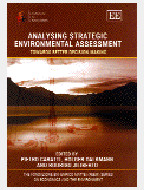Analysing Strategical Environmental Assessment : towards Better Decision-making

01.03.2004
Pietro Caratti, Holger Dalkmann, Rodrigo Jiloberto
Edward Elgar, Series on Economics and the Environment
Analysing Strategic Environmental Assessment (ANSEA) is an insightful
new approach to environmental evaluation, based on decision theory,
policy analysis and environmental considerations. These concepts, though
not new in their own fields of application, are combined and integrated
in an innovative fashion. The book presents recent research on the
implementation of the ANSEA approach which aims to ensure environmental
values are properly integrated into the decision-making process. ANSEA
was developed to contribute to the systematic integration of
environmental protection objectives in strategic decision-making which,
in turn, will contribute to the promotion of sustainable development.
The method can be applied to analyse how environmentaland sustainability
issues are addressed in decision-making processes at both the national
and local level for a variety of different policies. Importantly, the
focus is on evaluating the decision-making process itself, rather than
the quantitative output of an assessment. With explicatory examples, the
authors illustrate how a decision-centred approach to environmental
assessment can be successfully achieved. At a time when a new European
directive requires the implementation of strategic environmental
assessment (SEA) into all relevant decision-making processes, this
timely book will be required reading for environmental policymakers in
all EU member states. It will also be a valuable source of information
and reference for researchers, academics and consultants in the fields
of planning, environmental evaluation and environmental management.
Contributors: M. Alvarez-Arenas, O. Bina, D. Bongardt,
P. Caratti, H. Dalkmann, M. Garcia, G. Haq, R. Jiliberto, A.
MacGillivray, M. Nilsson, M. Tamborra, R. Tarquini
Analysing Strategic Environmental Assessment (ANSEA) is an insightful new approach to environmental evaluation, based on decision theory, policy analysis and environmental considerations. These concepts, though not new in their own fields of application, are combined and integrated in an innovative fashion. The book presents recent research on the implementation of the ANSEA approach which aims to ensure environmental values are properly integrated into the decision-making process. ANSEA was developed to contribute to the systematic integration of environmental protection objectives in strategic decision-making which, in turn, will contribute to the promotion of sustainable development. The method can be applied to analyse how environmentaland sustainability issues are addressed in decision-making processes at both the national and local level for a variety of different policies. Importantly, the focus is on evaluating the decision-making process itself, rather than the quantitative output of an assessment. With explicatory examples, the authors illustrate how a decision-centred approach to environmental assessment can be successfully achieved. At a time when a new European directive requires the implementation of strategic environmental assessment (SEA) into all relevant decision-making processes, this timely book will be required reading for environmental policymakers in all EU member states. It will also be a valuable source of information and reference for researchers, academics and consultants in the fields of planning, environmental evaluation and environmental management.
Contributors: M. Alvarez-Arenas, O. Bina, D. Bongardt, P. Caratti, H. Dalkmann, M. Garcia, G. Haq, R. Jiliberto, A. MacGillivray, M. Nilsson, M. Tamborra, R. Tarquini
